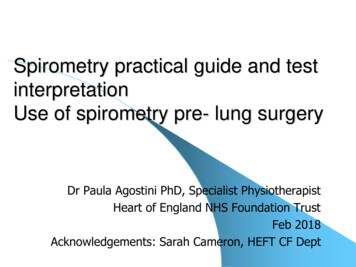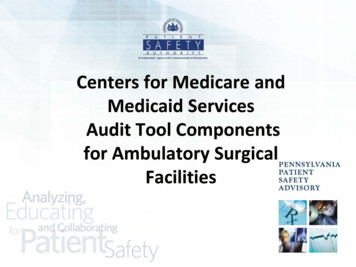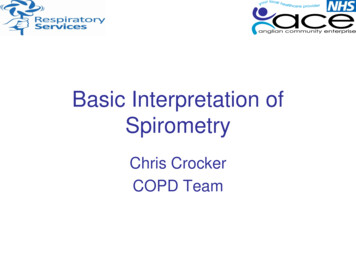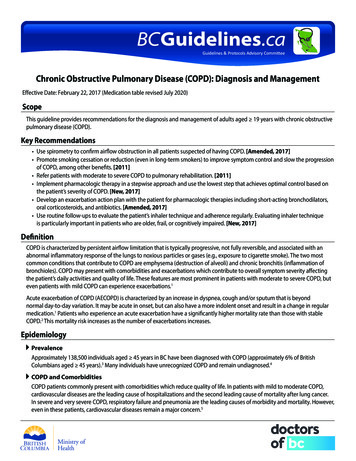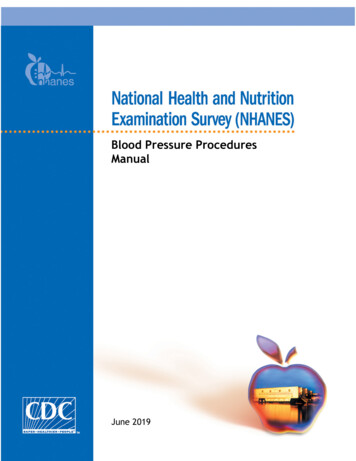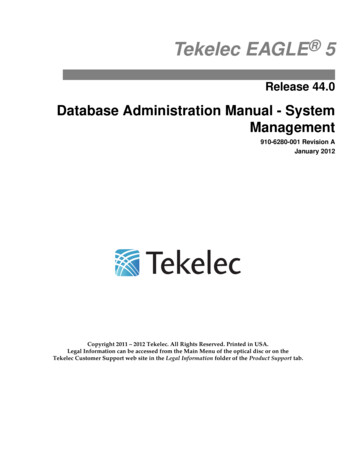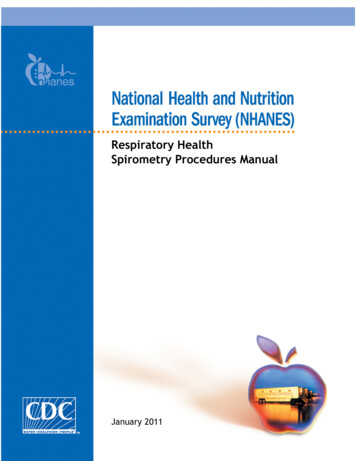
Transcription
Respiratory HealthSpirometry Procedures ManualJanuary 2011
TABLE OF CONTENTSChapter12PageSPIROMETRY OVERVIEW MENTS AND REFERENCES .1-13EQUIPMENT AND SUPPLIES .2-12.12.2List of Equipment and Supplies .Description of Equipment and Supplies .2-12-22.2.12.2.2Equipment .Supplies .2-22-3Equipment Setup Procedures .2-42.3.12.3.2Equipment .Supplies .2-42-6Equipment Care and Maintenance .2-62.4.12.4.2Spirometer .Hoses .2-62-7Equipment Packup Procedures .2-72.5.12.5.2Equipment .Supplies .2-82-8EXAMINATION PROTOCOL .3-12.32.42.53Overview of the Spirometry Exam Component.The Bronchodilator Subcomponent .Chronic Obstructive Pulmonary Disease .Asthma .Basics of Respiration .Spirometric Measurements .3.13.23.3Eligibility Criteria for Spirometry and BronchodilatorComponents .Spirometry Safety Exclusion Questions .Spirometry Examination Procedures .3-13-13-63.3.13-7Spirometry Testing Procedures .iii
TABLE OF CONTENTS -83-103-163-18Troubleshooting Spirometry Examinations .3-203.4.13.4.2Spirometer .Weather Station .3-203-22Report of Findings .3-23QUALITY CONTROL .4-14.1Equipment Cleaning and Calibration truction and Preparation .Initiate Test.End of Test .Procedures for Repeat Spirometry Testing .Quality Control Checks Screens .Equipment Cleaning .Equipment Calibration .Equipment Maintenance .Review of Results During the Exam.Observation .Review of Exam Status .Review of Results During Analysis .NIOSH Quality Control 04-114-114-11Operator Reports .Statistics .Grades .Summary and Trend Analysis Reports.SAFETY PROCEDURES .5-15.1Spirometry Safety Precautions.5-15.1.15.1.25.1.3Safety Exclusion Screening.Infection Control Measures .Prevention of Electric Shock .5-15-15-2Standing vs. Sitting During Spirometric Testing .Comprehension or Language Difficulties .Emergency Procedures .5-25-35-35.25.35.4iv
TABLE OF CONTENTS (continued)List of AppendixesAppendixPageANIOSH Spirometry System Design Criteria .A-1BScreenshots for Spirometry Safety Exclusion Questions .B-1List of TablesTable1-1Lung diseases and spirometry results .1-123-1Spirometry safety exclusion items by age .3-2List of FiguresFigure1-1The respiratory tract .1-51-2Normal volume-time curve .1-81-3Normal flow-volume curve .1-81-4FVC and FEV1 on a normal volume-time curve .1-91-5FVC on normal flow-volume curve .1-91-6Normal and restrictive patterns volume-time curves .1-101-7Flow-volume curves .1-101-8Obstructive pattern shown on a volume-time curve .1-111-9Obstructive pattern shown on a flow-volume curve .1-11v
TABLE OF CONTENTS (continued)List of ExhibitsExhibitPage3-1Aneurysm help screen .3-33-2Spirometry exclusion .3-43-3End of subsection screen.3-43-4End of exam screen .3-53-5Begin spirometry test screen .3-63-6OMI/NIOSH main program screen .3-73-7Temperature warning message .3-73-8Proceed with testing screen.3-83-9Curve display screen – pre-test .3-103-10Curve display screen .3-113-11Test results screen .3-123-12Results and quality code box .3-133-13Override acceptability code screen .3-153-14Post-Test data screen .3-163-15End of subsection – complete screen .3-173-16End of exam screen .3-183-17Technologist bronchodilator referral script screen .3-193-18End of exam – SP to bronchodilator screen .3-194-1Quality Control Checks – Start of Stand QC .4-24-2Quality Control Checks – Daily QC .4-24-3Quality Control Checks – Start of Session QC .4-3vi
TABLE OF CONTENTS (continued)List of Exhibits (continued)ExhibitPage4-4Quality Control Checks – Weekly QC.4-34-5Quality Control Checks – End of Stand QC .4-44-6Quality Control Checks – Not Done QC .4-44-7Operator Report .4-104-8Quality Control Summary Report .4-124-9Calibration Summary Report .4-124-10Trend Analysis Report .4-13vii
1. SPIROMETRY OVERVIEW1.1Overview of the Spirometry Exam ComponentSpirometry, which means “the measuring of breath,” is a routinely used pulmonary functiontest (PFT) that measures the amount and speed of air that a person can inhale and exhale. Results from thetest can be used to estimate lung function and aid in the diagnosis of certain respiratory disorders. Thecurrent NHANES spirometry component is sponsored by the Centers for Disease Control and Prevention,National Institute for Health Statistics (CDC/NCHS), the National Heart, Lung, and Blood Institute(NHLBI), and the National Institute for Occupational Safety and Health (NIOSH). The objective of the2007-8 spirometry data collection cycle is to assess the prevalence of asthma and adult chronicobstructive pulmonary disease (COPD) in the U.S. population. The data will also be used to produceupdated spirometric reference data for the general population. Moreover, comparisons of 2007-8 datawith that of previous studies will illuminate trends in asthma and COPD prevalence over time in theUnited States.Prior to the current survey, NHANES III (1988-1994) also included a spirometry1component. These spirometry data were used to generate age, gender, and race/ethnicity specificprediction equations for normal spirometric values.2 These reference standards have been widely used inresearch relating to occupational pulmonary disease, the effects of air quality on spirometric function, andin particular the relationship of smoking to COPD. The data from the NHANES III survey have been usedalso in evaluation of asthma and COPD prevalence and their risk factors in the general U.S. population.3,4All sample persons (SPs) aged 6-79 years will be eligible to participate in the spirometrycomponent. The procedures are based on the current standards for pulmonary function, equipment,testing, and interpretation set by the American Thoracic Society (ATS).5,6 Spirometry training is requiredfor all health technologists and will be provided by NIOSH.Spirometry is part of the Respiratory Health (RH) component, together with Exhaled NitricOxide (ENO) testing (please refer to the ENO Procedures Manual for further details). The spirometrycomponent will include a subcomponent in which the spirometry exam will be repeated on a small subsetof participants following the administration of a bronchodilator medication. This will make it possible todistinguish between COPD and asthma, which have similar baseline spirometry profiles but differ in post-1-1
bronchodilator spirometry testing. This distinction is important because, although asthma and COPD havesimilar symptoms, they are associated with different risk factors and molecular and patho-physiologicmechanisms. The bronchodilator evaluation will be conducted by the MEC physician (see BronchodilatorComponent Procedures Manual for details).1.2The Bronchodilator SubcomponentThe main difference between the 2007 spirometry component and spirometry duringNHANES III is the addition of the bronchodilator subcomponent. Participants whose baseline spirometryresults show lung function values below a certain threshold will be asked to repeat spirometry afterinhaling a β2-adrenergic bronchodilator medication that acts to open constricted airways. Typically,asthma patients show marked improvements in post-bronchodilator spirometry testing, while patientswith COPD exhibit little, if any, response to the medication. Therefore, results from repeat spirometrytesting following the bronchodilator could potentially provide a more detailed picture of each individual’sbreathing problem, i.e., an indication of whether the person is likely to have asthma or COPD.In clinical settings, spirometric testing using β2-adrenergic bronchodilator administration hasbeen routinely employed to diagnose asthma in both children and adults since the 1970s. Moreover,albuterol inhalers have been approved for administration to persons 4 years of age and older. Further,current U.S. National Heart, Lung and Blood Institute (NHLBI) Expert Panel Report Guidelines for theDiagnosis and Management of asthma7 state that post-bronchodilator spirometry testing is essential forthe initial diagnosis of asthma; hence, its routine diagnostic use in both children and adults is considered aclinical standard or “best practice.” The American Thoracic Society has described standards for theinterpretation of bronchodilator response testing.8,9The addition of spirometry to NHANES in 2007 marks the first year that a bronchodilatormedication has ever been administered in the survey. However, spirometry with post-bronchodilatortesting has been successfully employed in many major population-based surveys, in both children andadults. A major example for children is the Southwestern Children’s Respiratory Study in Arizona, acontinuous longitudinal community-based study of 1,250 children studied from birth in 1980 to thepresent. 10 For adults, major current examples are the European Community Respiratory Health Survey ofmen and women at 36 sites in the European Union,11 and the Platino Project, a multicountry survey inLatin American urban settings.12 Currently, the Framingham, Massachusetts study is also deploying post-1-2
bronchodilator spirometry.13 We have derived our safety exclusion protocols for bronchodilatoradministration based on these and other epidemiological studies.In summary, bronchodilator testing is not planned to be administered to healthy participants,but only to a survey subpopulation with abnormal baseline spirometry (i.e., those persons with a highlikelihood of clinical obstructive respiratory disease). This subgroup is intended to be similar to the set ofrespiratory disease patients who would routinely receive such testing in clinical settings.Since a β2-adrenergic bronchodilator is a prescription medication, the MEC physician willadminister the bronchodilator only after he or she obtains informed consent and completes a review ofsafety exclusions that would prohibit the participant from taking the medication. For example, individualswho are taking particular types of medications (e.g., antiarrythmics, anticonvulsants, and someantidepressants) or who have certain heart conditions (i.e., high blood pressure, high pulse, etc.), will beexcluded from the bronchodilator portion of spirometry for safety reasons.1.3Chronic Obstructive Pulmonary DiseaseThe term chronic obstructive pulmonary disease (COPD) refers to a group of conditionscharacterized by progressive development of airflow limitation that is usually not fully reversible withmedication treatment. Chronic obstructive bronchitis and emphysema are two serious conditions thatcause COPD. Although both conditions may result in irreversible airway obstruction, they exhibitdifferent pathologic mechanisms leading to COPD. For example, in chronic bronchitis, airflow limitationis caused by obstruction of small airways in the lung due to inflammation and excessive bronchial mucussecretion. In emphysema, airflow limitation is caused by the destruction of elastic tissue in the respiratorypart of the lung where gas exchange occurs (respiratory bronchioles and alveoli), resulting in air trappingand decreased oxygen to the body.COPD is a serious public health problem in the United States and is responsible forextensive morbidity and mortality in the American population. According to the most recent NCHSstatistics (based on data from 2002), COPD is the fourth leading cause of death in the United States andwas responsible for 124,816 American deaths in 2002.14 In fact, this statistic is probably anunderestimation of COPD mortality since the disease is often a cofactor in other leading causes of death1-3
such as heart disease. Despite the important role of genetic and environmental factors in causing COPD,most cases are related to cigarette smoking or other environmental exposures, and thus are preventable.Because COPD is a major cause of death in the United States, there is a need for continuedmonitoring of its prevalence in the general population. The inclusion of spirometry in the currentNHANES survey will lead to more up-to-date and detailed estimates of the nationwide prevalence of andrisk factors for COPD.1.4AsthmaBoth asthma and COPD are characterized by chronic airway inflammation. However, theinflammatory mechanisms and general disease profiles of the two conditions are very different. As aresult, COPD and asthma affect different types of people and respond to different types of treatment.Asthma has many different clinical manifestations but is generally characterized by airflowobstruction, bronchial hyper-responsiveness, and airway inflammation. Similar to COPD, asthma iscaused by a combination of genetic and environmental factors. Unlike COPD, however, the inflammatoryreaction involved in asthma may often be an allergic-type reaction, meaning that the inflammatoryresponse (or asthma attack) can be brought on by the inhalation of some sort of allergen.Asthma is widely prevalent in the American population. According to self-reported datafrom the 2004 National Health Interview Survey, approximately 7.3 percent of the U.S. population suffersfrom asthma, and prevalence is higher among children than adults. The addition of spirometry into thecurrent NHANES will provide new evidence-based information about the nationwide prevalence ofasthma in both children and adults.One treatment for asthma is the administration of β2-adrenergic inhalants (bronchodilators),which act quickly and effectively to open constricted airways. Conversely, β2-adrenergic inhalants havelittle or no effect among patients with COPD. This allows diagnoses of asthma and COPD to bedistinguished based on a subject’s response to the inhaled bronchodilator. The inclusion of thebronchodilator portion of the new spirometry component will allow for separate analyses of theprevalence of asthma and COPD in NHANES data output.1-4
1.5Basics of RespirationThe respiratory tract consists of the trachea, lungs, bronchi, bronchioles, and alveoli asshown in Figure 1-1. The alveoli constitute both the functional unit of the lung and the site of cellularFigure 1-1. The respiratory tractrespiration. From the trachea, the airways divide progressively like branching trees in both symmetricaland asymmetrical fashion: each branch of airways leading away from the trachea becomes smaller, but inturn the total area of cross-sectional airways actually increases. As a result, airflow resistance decreases asair moves from the large airways to the smaller bronchioles.The movement of air in and out of the lungs is called ventilation, that includes bothinspiration and expiration. Inspiration, or inhalation, is an active process that utilizes muscles in the chest,primarily the diaphragm. Expiration, or exhalation, is normally a passive process that requires littlemuscular activity unless air is forcefully expelled from the lungs, such as during a forced vital capacitymaneuver (see Section 1.6). The main purpose of the respiratory tract is to conduct air between theexternal environment and the surface of the alveoli to permit an exchange of oxygen and carbon dioxide.1-5
Spirometry testing does not directly measure the rate of oxygen transfer to the lungs; rather it measureslung volume and air flow rates, which are major factors that influence the process of oxygen transfer.The exchange of oxygen from the outside environment for carbon dioxide from venousblood defines the fundamental process of respiration. This exchange occurs at the surface of each of theapproximately 300 million alveoli contained in the lungs. The alveoli have a combined total surface areafor gas exchange that is equivalent to the size of a tennis court.The lung is served by two blood supplies: pulmonary and bronchial. Pulmonary circulationpumps oxygen-depleted venous blood from the heart through the pulmonary arteries and to the lungs to beoxygenated before being pumped by the heart to the rest of the body. Bronchial circulation arises from theaorta (the largest artery coming from the heart) and pumps oxygenated blood to the lungs, providing theprimary supply of blood for the lung tissue itself.Finally, it is important to remember that, while the main purpose is to facilitate the transferof oxygen and carbon dioxide, the lung also serves other functions: metabolism and detoxification of awide range of substances; protection against infectious agents and environmental pollutants; and thesynthesis of important compounds such as prostaglandins, which are important in inflammatory reactions.1.6Spirometric MeasurementsThe NHANES spirometry protocol relies on certain standard spirometric measurements toassess lung function. Participants perform the spirometry test using a spirometer, a device that measuresthe amount of air a subject exhales and the rate at which he or she exhales the air. The basic standardspirometric test requires the subject to exhale as forcefully as possible after taking in a full, deep breath.The subject’s effort is called the forced expiratory maneuver. In the current NHANES, eachparticipant’s individual spirometric measurements are compared to standards established from NHANESIII data.2 These standards are calculated based on an individual’s age, height, sex, and race/ethnicity sincethe diagnostic thresholds for obstructive lung disease differ by body size and by demographic subgroups.The following standard measurements will be used in the NHANES spirometry component:Forced Vital Capacity (FVC): The maximum volume of air exhaled forcefully after amaximal inspiration. For adults, this forced exhalation should last at least 6 seconds; however, persons1-6
with COPD may take considerably longer to exhale all their air. Children under the age of 10 should becoached to exhale for at least 3 seconds.NOTE: FVC should not be confused with vital capacity (VC), which is defined as themaximum amount of air that the subject can breathe out after the deepest inspiration, whether or not theair was exhaled forcefully. In subjects without airway obstruction, the FVC is usually equal to the VC.Also, some residual air always remains to keep the lungs partially inflated even after a maximum FVCmaneuver is completed; thus, the FVC does not measure the total lung volume.Forced Expiratory Volume in One Second (FEV1): The volume of air exhaled during thefirst second of a forced expiratory maneuver. Normally, a healthy person can be expected to exhale from70 to 80 percent of the FVC in the first second of a forced expiration maneuver.Peak Expiratory Flow (PEF): The highest instantaneous airflow rate measured during theFVC maneuver. PEF is measured in liters per second and will be used mainly to assess participant effort.In the current NHANES spirometry study, the primary measurement used to assessobstructive lung disorders will be the ratio of forced expiratory volume in 1 second to forced vitalcapacity expressed as a percentage, or FEV1/FVC%. Sample persons will be assigned to thebronchodilator subcomponent for further testing if their baseline spirometric testing results exhibit thefollowing: FEV1/FVC% less than the Lower Limit of Normal (LLN) determined for their age,height, sex, and race/ethnicity or FEV1 /FVC% less than 70 percent.Additionally, participants showing a FEV1/FVC% less than 50 percent of that predictedbased on their demographic characteristics will automatically be sent to the MEC physician (i.e., personslikely to have severe obstructive lung disease), who will assess whether referral to a community provideris necessary.Spirometric data are viewed as graphs called spirograms. Measurements of exhaled volume(in liters), time (in seconds), and airflow rates (in liters per sec) are determined and displayed on thespirograms. There are two types of spirograms that will be used in the NHANES spirometry component: Volume-Time: The basic volume vs. time curve contains points corresponding to theFEV1 and FVC and1-7
Flow-Volume: The expiratory flow vs. volume curve displays instantaneous airflowrates as a function of volume exhaled. This curve also contains points correspondingto the PEF and FVC.Figures 1-2 and 1-3 illustrate a normal volume-time curve and a normal flow-volume curve,respectively.FVCFEV1Figure 1-2. Normal volume-time curveFigure 1-3. Normal flow-volume curve1-8
In the following illustrations, the values for FVC and FEV1 are shown in a normal volumetime curve (Figure 1-4). The FVC is shown again in a flow-time curve (Figure 1-5).Figure 1-4. FVC and FEV1 on a normal volume-time curveFigure 1-5. FVC on normal flow-volume curve1-9
Spirograms may be used to classify participants as normal, having an obstructive patternand/or a restrictive pattern. Specifically, a low FVC is indicative of a restrictive disorder, and typicallythese individuals will also have a low FEV1. A low FEV1/FVC% ratio may indicate an obstructiveimpairment. On average, typically 70-80 percent of the FVC is exhaled in the first second from a personwho is healthy. However, a person with airway obstruction may be able to exhale only 60 percent or lessof the FVC in the first second even though the FVC may be normal. Additionally, some persons mayshow evidence of a combination of both airway obstruction and restrictive disease. Figures 1-6 and 1-7show examples of normal compared to restricted curves, while Figures 1-8 and 1-9 show examples ofcurves resulting from persons with obstructive lung disorders.Figure 1-6. Normal and restrictive patterns volume-time curvesFigure 1-7. Flow-volume curves1-10
Figure 1-8. Obstructive pattern shown on a volume-time curveFigure 1-9. Obstructive pattern shown on a flow-volume curveAlthough spirometry can provide useful diagnostic and screening information, it has somelimitations. Table 1-1 provides a brief interpretation of spirometry results based on values obtained forFVC, FEV1, and FEV1/FVC%. Test results can show restrictive or obstructive disease patterns, but theyare not disease-specific. For example, a person’s spirogram may show a low FEV1, but a physician maynot be able to determine whether the cause is from asthma, chronic bronchitis, or some other obstructivedisease. A low FVC (an overall reduction in measured lung volume) may be due to emphysema or to lungscarring such as from asbestos or silica exposure. Additional information, such as a physical examination,chest X-rays, and health and occupational histories, is always needed to make a diagnosis.1-11
Table 1-1.Lung diseases and spirometry resultsInterpretationNormal spirometryFVCNormalFEV1NormalFEV1/FVC%NormalAirway obstructionLow or normalLowLowLung restrictionLowLowNormalCombination of obstructionand restrictionLowLowLowFinally, spirometry can often detect obstructive diseases in their early stages but, for certainrestrictive diseases, spirometric testing may not be sensitive enough to show abnormalities beforeextensive and, in some cases, irreversible damage has been done. For example, signs of overt lung diseaseand lung scarring may be found on chest X-rays while spirometry results are still normal. Thus, whilespirometric testing is important, spirometry should not be used as the sole screening tool of a respiratorydisease survey program, or as the sole criterion for a clinical diagnosis of disease.1-12
ACKNOWLEDGMENTS AND REFERENCESThe technical descriptions and documentation of the NIOSH Spirometry System andexamination procedures were provided by John Hankinson, Ph.D. from Hankinson Consulting, Inc. andLu-Ann Beeckman-Wagner, Ph.D, from the NIOSH Laboratory in Morgantown, West Virginia.1.Third National Health and Nutrition Examination Survey III: Spirometry Procedure NHANESII
The addition of spirometry to NHANES in 2007 marks the first year that a bronchodilator medication has ever been administered in the survey. However, spirometry with post-bronchodilator testing has been successfully employed in many majo
